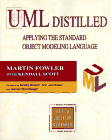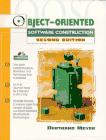UML Distilled: Applying the Standard Object Modeling Language
by Martin Fowler and Kendall Scott
 This is a concise, readable and extremely useful description of the Unified Modeling Language (UML).
UML -- designed by Booch, Jacobson, and Rumbaugh -- is a merger of the most popular
object-oriented notations; by design, it can be used with any method.
The book assumes prior knowledge of some OO method.
The authors help the reader understand what UML is and what it is good for,
including their evaluation throughout the book. You will learn more than
with the official UML notation guide.
Fowler is a known expert, full of common sense; he has managed to produce
a vital book for object-oriented practitioners.
Includes examples in Java and C++, and an excellent bibliography.
(179 pages, 1997)
This is a concise, readable and extremely useful description of the Unified Modeling Language (UML).
UML -- designed by Booch, Jacobson, and Rumbaugh -- is a merger of the most popular
object-oriented notations; by design, it can be used with any method.
The book assumes prior knowledge of some OO method.
The authors help the reader understand what UML is and what it is good for,
including their evaluation throughout the book. You will learn more than
with the official UML notation guide.
Fowler is a known expert, full of common sense; he has managed to produce
a vital book for object-oriented practitioners.
Includes examples in Java and C++, and an excellent bibliography.
(179 pages, 1997)
Prices & orders:
softcover ** ($29.00)
Object-Oriented Analysis and Design with Applications, 2/e
by Grady Booch
 This book can be seen as a transition from Booch's original
work to a "unified notation" focus which incorporates the proposals of
other methodologists. The book is very well-written and easy to read,
but it should not be used as a single source for the definition and
execution of a complete object-oriented development process.
Booch is at his best when he explains the concepts of object-orientation
(part I). Although part II claims to be about method, it is more about
notation--and there is a lot of it, too much in some respects. Finally,
part III shows applications of the "Booch method", but reading it can be
frustrating because this part lacks many steps and explanations which
would have made the examples more understandable and useful to learn
the method in action (for instance, chapter 11 is a confusing treatment
of the blackboard model). As a consequence the reader will have to test-drive
the Booch method to see how it fits in his development environment.
This book can be seen as a transition from Booch's original
work to a "unified notation" focus which incorporates the proposals of
other methodologists. The book is very well-written and easy to read,
but it should not be used as a single source for the definition and
execution of a complete object-oriented development process.
Booch is at his best when he explains the concepts of object-orientation
(part I). Although part II claims to be about method, it is more about
notation--and there is a lot of it, too much in some respects. Finally,
part III shows applications of the "Booch method", but reading it can be
frustrating because this part lacks many steps and explanations which
would have made the examples more understandable and useful to learn
the method in action (for instance, chapter 11 is a confusing treatment
of the blackboard model). As a consequence the reader will have to test-drive
the Booch method to see how it fits in his development environment.
Note that contrary to what the title of the book implies, there is no analysis
in this method--it assumes the existence of some acceptable set of
requirements as a starting point.
The extensive, classified bibliography can be very useful for those who wish
to deepen their grasp of specific subjects.
Unfortunately, program examples are in C++ only (the 1st edition did use other languages too).
One of the best books in the OO market.
(589 pages, 1995)
Prices & orders:
hardcover *** ($62.35)
Object-Oriented Software in Ada 95
by Michael A. Smith
Smith explains how to apply the Fusion method
with Ada 95 as the implementation language.
The 24 chapters of the book cover the whole core language and are organized around
a detailed case study.
This book is suitable for self-study, and is best read together with the original Fusion book
and a more complete "programming with Ada 95" book.
End-of-chapter exercises and self-assessment questions are included.
The annexes summarize the language syntax and the predefined library, and include answers
to selected exercises.
Unfortunately the book is marred by a strange typographical presentation, but it is still
a valuable resource for object-oriented developers who use Ada 95.
Source code for the examples is available on the Internet.
(460 pages, 1996)
See also:
Ada 95 book reviews
Prices & orders:
softcover ** ($34.95)
Object-Oriented Modeling and Design
by James Rumbaugh et al.
 This book is the source of the OMT method (Object Modeling Technique).
It is detailed and practical, an ideal support to start and/or refresh
your application of object-oriented methodology.
The values of this book are that it applies object-oriented techniques to much
of the software development cycle (as usual, the "modeling" part assumes an existing "analysis"),
shows how to solve problems frequently encountered in designing OO software,
introduces useful graphical notations, and does all this in a clear prose.
Contains also a discussion of implementation in non-OO languages,
such as C, Fortran, and Ada 83 (yes, this book was published in 1991!).
Definitely a good addition to the knowledge and skills of the object-oriented developer.
(500 pages, 1991)
This book is the source of the OMT method (Object Modeling Technique).
It is detailed and practical, an ideal support to start and/or refresh
your application of object-oriented methodology.
The values of this book are that it applies object-oriented techniques to much
of the software development cycle (as usual, the "modeling" part assumes an existing "analysis"),
shows how to solve problems frequently encountered in designing OO software,
introduces useful graphical notations, and does all this in a clear prose.
Contains also a discussion of implementation in non-OO languages,
such as C, Fortran, and Ada 83 (yes, this book was published in 1991!).
Definitely a good addition to the knowledge and skills of the object-oriented developer.
(500 pages, 1991)
Prices and orders:
hardcover *** ($65.00)
Object-Oriented Software Construction, 2/e
by Bertrand Meyer
 Meyer, designer of the Eiffel programming language, is one of
the founders of object-oriented software development. The first edition
of his book introduced many developers to the concepts underlying
object-orientation. This new edition is a thoroughly revised and
expanded version, with the same virtues of clarity, comprehensiveness,
and practicality that made the first edition a major reference in the
field.
Meyer, designer of the Eiffel programming language, is one of
the founders of object-oriented software development. The first edition
of his book introduced many developers to the concepts underlying
object-orientation. This new edition is a thoroughly revised and
expanded version, with the same virtues of clarity, comprehensiveness,
and practicality that made the first edition a major reference in the
field.
Meyer's writing style is clear and concise; he holds many ideas that are
dear to the hearts of Ada users and has definite visions of where
software development is headed. The book includes completely updated
discussions of essential topics, such as reusability, modularity,
software quality, object-oriented languages, and memory management.
Meyer evaluates object-oriented programming languages (using Eiffel as
the standard). Definitely a must read, which you are likely to use as a
reference work over and over. The book comes with a CD full of object
tools and containing the entire book in PDF for computer-based reading.
(1254 pages + CD, 1997)
Prices & orders:
softcover+CD *** ($70.00)
Winter 1996-97 Spotlight
Ada 95: The Craft of Object-Oriented Programming
by John English
This book introduces Ada-as-a-first-language, using an example-driven
approach that gradually develops small programs into large case studies.
Even for one who already knows Ada, it is a pleasure to read, especially as it
emphasizes an object-oriented perspective on the development of Ada applications.
The reader is quickly introduced to "high-level" mechanisms, such as exception handling
and the hierarchical library (interestingly, the author systematically creates his
examples in a namespace hierarchy rooted at a package aptly named "JE").
The book is very well written and appropriately stresses many software engineering
concerns throughout the 20 chapters; for instance, maintenance scenarios are used to
underscore the essential design choices faced at various stages of development.
Four annexes summarize the syntax of the language and essential predefined entities.
Tasking is described, but not in detail.
(486 pages, 1996)
See also:
Ada 95 book reviews
Prices & orders:
softcover ** ($38.80)